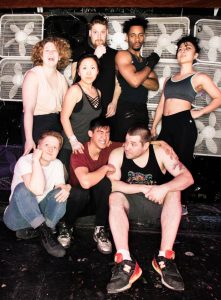"Have you ever punched anyone in the face?" an actor—coincidentally, the biggest on the stage—asks the audience at the start of the show, A Story Told in Seven Fights, his query quickly followed by, "Have you ever wanted to punch somebody in the face?" This is not a frivolous question, since one of the three stories promised in the title is that of Gilded Age Swiss playboy Arthur Cravan. Not content with the notoriety arising from his familial connection to the scandal-besieged Oscar Wilde (married to Cravan's aunt Constance), the incorrigible bad boy cultivated a public image based in the exaggerated masculinity associated with exotic foreign cultures like our own Wild West, proclaimed in spontaneous displays of pugilism and even going so far as a boxing match with the African-American heavyweight champion Jack Johnson. Such Rimbaudian audacity inevitably drew the attention of experimental artists also bent on unsettling what they deemed a status quo in need of a good punch in the you-know-what. These rebels included the Dadaists and the Surrealists, whose progress—under the self-appointed leadership of, respectively, Tristan Tzara and Andre Breton—was rendered divisive from its very outset by the inevitable dissent characterizing ideologies predicated on the rejection of reason and order. The third story finds its inspiration in a faction almost bereft of textual reference: the Italian Futurists, whose manifesto confers permission on the play's performers, as well as the personae, to express their opinions on the topics under discussion. Since the ensemble for this Neo-Futurist production encompasses a diversity of genders and ethnicities, this ensures a variety of observations on the concept of provocation as art, the boundaries of that provocation and the propensity of angry youth to embrace the former before coming up against the latter. "The world that artists occupied at the beginning of the 20th century is very similar to ours," said Trevor Dawkins, credited in the playbill as the play's author, "Their response to tumultuous changes in Europe and North America was to assume increasingly radical positions regarding their role in society. This, in turn, affected how they engaged with one another." Director Tony Santiago concurred, saying, "How often do we hear people say `Fight for what you believe in!’—but what does that mean? We wanted to explore what makes people turn to violence, when words aren’t enough, and whether, in fact, that moves us closer to our goals, or farther away." Don't come expecting a stunt-show, though, warned fight choreographer Gaby Labotka, who told Windy City Times, "The conversation is about art as disruption, and our stage combat is merely the vehicle for that conversation." She cited, as an example, a fight scene depicting the premiere of the Ballets Russes Romeo et Juliette in 1926, where the costumes and scenery were designed by surrealist artists Joan Miro and Max Ernst, but was interrupted when Andre Breton and his cohorts, who disapproved of their modern art being employed in service of what they felt was a bourgeois capitalist venture, proceeded to create such a disturbance that the production had to be stopped. So what is Dawkins’s purpose in resurrecting these historical events? "I think there are valuable lessons for us, today, to be learned from looking at groups trying to solve a common problem with conflicting strategies. What actions—inciting riots, attacking strangers on the street—are likely to succeed in bringing about the paradigm shift we want, and which ones are doomed to failure?" The question that Labotka felt we need to ask ourselves was "Why were artists and audiences of that time so ready to fight, compared to now? What changed?"

